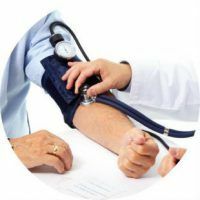
Calcium antagonists or calcium channel blockers( CCBs) are a group of drugs against hypertension that differ in chemical structure but have a similar mechanism of action. The list contains more than 20 substances, each of which has different effects on the human body. Most medicines are used in the therapeutic field, some have found application in neurology and gynecology.
- action mechanism Indications
- Classification
- Contraindications
- Side
- effects during pregnancy
- Formulations
- derivatives dihydropyridine
- Amlodipine( Amlotop, Norvasc)
- Isradipine( Lomir)
- lacidipine( Latsipil, Sakura)
- Lercanidipine( Zanidip-Lekordati, Lercamen)
- Nicardipine( Barizin, Perdipin)
- Nimodipine( Braleal, Nemotan, Nimotop, Nimopin)
- Nifedipine( Cordaflex, Cordipine, Nifecard, Fenigidine)
- Felodipine( Plendil, Felodip, Felotenz Retard)
- derivatives fenilalkilamina
- verapamil( Isoptin, finoptinum)
- gallopamil( Prokorum)
- benzothiazepine derivative
- Diltiazem( Diakordin)
- derivatives difenilpiperazima
- Flunarizine( Sibelium)
- Cinnarizine( Stugezin, stugeron)
mechanism of action
Calcium is involved in the transfer ofimpulses from nerve receptors to intracellular structures that cause cells to strain and contract. Calcium ions enter the cell through the so-called slow channels( or L-channels) embedded in the cell membranes of the muscles of the vessels, heart and skeleton, as well as neurons of the cerebral cortex. One of the causes of hypertension is an elevated cell concentration in cells and a lowered one in blood plasma, which causes vascular and cardiac cells to react more strongly to stimulating hormones and other biologically active substances.
CCB interferes with the penetration of calcium from the blood into the cell and affects the intracellular movement of the element, resulting in:
- dilating the coronary vessels, improving blood flow in the heart muscle, better oxygen supply to the myocardium and removal of metabolic products from it;
- reduced heart rate, which reduces the need for oxygen in the heart;
- improved diastolic function of the myocardium( ability to relax);
- enlargement of peripheral arteries, which contributes to lowering blood pressure;
- reduced aggregation( adhesion) of platelets, which prevents the appearance of thrombi;
- improved cholesterol metabolism, reduced lipid oxidation.
Indications for use
- Arterial hypertension;
- pulmonary hypertension;
- angina;
- ischemic heart disease;
- myocardial infarction;
- aortic valve failure;
- hypertrophic cardiomyopathy;
- peripheral and cerebral circulatory disorders;
- atherosclerosis;
- subarachnoid hemorrhage;
- prevention of migraine attacks;
- Raynaud's syndrome;
- diffuse spasm of the esophagus;
- irritable bowel syndrome;
- obstructive pulmonary disease;
- dysmenorrhea( painful menstruation);
- premature delivery;
- urinary incontinence;
- epilepsy;
- glaucoma;
- dizziness, tinnitus, motion sickness.
Classification
Depending on the chemical structure:
- Dihydropyridine is a dihydropyridine derivative. This series of drugs has the advantage in the treatment of angina pectoris, hypertension, left ventricular hypertrophy of the heart, peripheral vascular atherosclerosis. The drugs increase the heart rate, so they are not used to treat arrhythmia.
- Non-dihydropyridine is a derivative of phenylalkylamine and benzodiazepine. They act simultaneously on the heart and on the vessels. They have pronounced anti-anginal( anti-ischemic), antiarrhythmic, hypotensive properties, reduce the frequency of heart contractions. Highly effective in the treatment of angina, supranventicular tachycardia, atherosclerosis of the carotid arteries.
- Non-selective calcium antagonists are derivatives of diphenylpiperazine. Virtually do not change the level of pressure, have a vasodilating effect, improving cerebral circulation.
There are also 3 generations of calcium antagonists:
- The first generation of ( verapamil, diltiazem, nifedipine) is the progenitor of the group of drugs, their disadvantages are low bioavailability( reaching the desired site of exposure) and rapid elimination from the body.
- The second generation of - is characterized by greater selectivity and duration of the effect, but their effectiveness is difficult to predict, and the peak concentration in the blood is achieved at different times.
- The third generation ( Amlodipine, Lacidipine, Lercanidipine) is represented only by a group of dihydropyridines, which have high bioavailability and tissue selectivity, remain longer in the blood, which is effective in the treatment of hypertension.
Contraindications
Similar to all calcium antagonists:
- reduced blood pressure;
- heart failure with reduced systolic function of the left ventricle( except for amlodipine and felodipine);
- serious violations of the liver and kidneys;
- pregnancy( Nifedipine is allowed, and in the II-III trimesters - Verapamil);
- lactation;
- age to 18 years( except for the group of piperazines);
- individual intolerance of the drug components.
- bradycardia;
- atrioventricular( atrioventricular) blockade of II and III degree without implantation of pacemaker;
- syndrome of weakness of the sinus node( without implantation of the pacemaker);
- syndromes of premature ventricular excitation with paroxysms of atrial fibrillation( flutter), with episodes of antidromic tachycardia;
- tachycardia with long duration of intraventricular excitation;
- concurrent use with beta-blockers.
Side effects of
For all BCC:
- pressure reduction;
- weakness, drowsiness, dizziness, headache;
- nausea, abdominal pain, vomiting, diarrhea;
- peripheral edema( usually affects the lower limbs - feet and ankles);
- sensation of fever and redness of the face( hot flashes);
- decreased systolic function of the left ventricle of the heart( except Amlodipine and Felodipine);
- allergic reactions.
- reflex tachycardia.
- For non-dihydropyridine:
- bradycardia;
- violations of atrioventicular conductivity;
- reduced automatism of the sinus node;
- constipation( characteristic of Verapamil);
- hepatotoxicity( verapamil).
When Pregnant
The use of calcium antagonists is possible in pregnant women with a blood pressure level exceeding 140-160 / 90-110 millimeters of mercury. In these cases it is better to use third generation drugs. However, with hypertensive crisis, the most effective is Nifedipine short-acting.
to contents ^Preparations
for table of contents ^Derivatives of dihydropyridine
to contents ^Amlodipine( Amlotop, Norvasc)
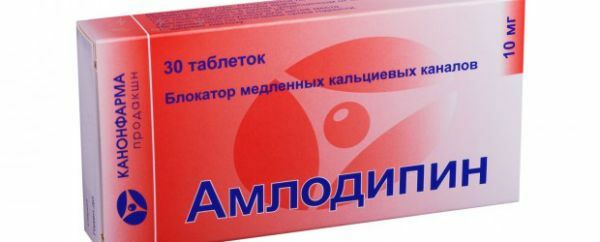
The active ingredient is amlodipine besylate. The form of release - tablets.
Indicated for arterial hypertension, stable angina pectoris and vasospastic angina( Prinzmetal).
Take 2.5-10 milligrams( 0.5-2 tablets) once a day.
to table of contents ^Isradipine( Lomir)
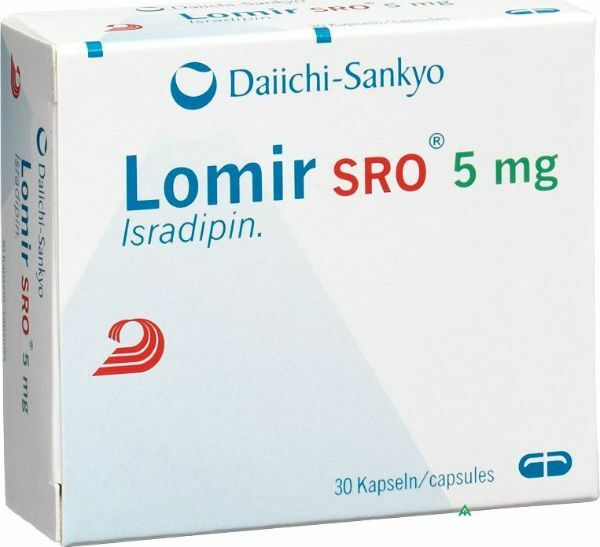
The active substance is isradipine. Form release - tablets, capsules retard, solution for injection.
Promotes the expansion of arterial vessels of the skeletal musculature, heart and brain, lowers arterial pressure, has a moderate natriuretic effect( removes sodium ions in the urine).
Take 1 capsule retard( 5 milligrams) once a day or 1 tablet( 2.5 milligrams) 2 times a day. Patients with hepatic or renal insufficiency or in old age are prescribed half of this dose. If there is no effect after 2-4 weeks, the dose can be doubled.
to contents ^Latsidipin( Latsipil, Sakur)
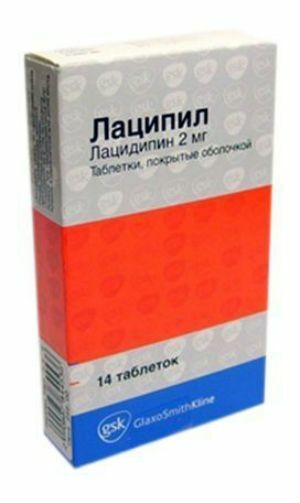
The active ingredient is lacidipine. The form of release - tablets.
The drug of the latest generation, affects the calcium channels of smooth muscle vessels, expanding the peripheral arterioles, reducing the overall peripheral vascular resistance( OPSS), reducing blood pressure.
Take 2 milligrams 1 time per day, if necessary, after 3-4 weeks, increasing the daily dose to 4, and then to 6 milligrams.
to contents ^Lercanidipine( Zanidip-Lecordati, Lercamen)
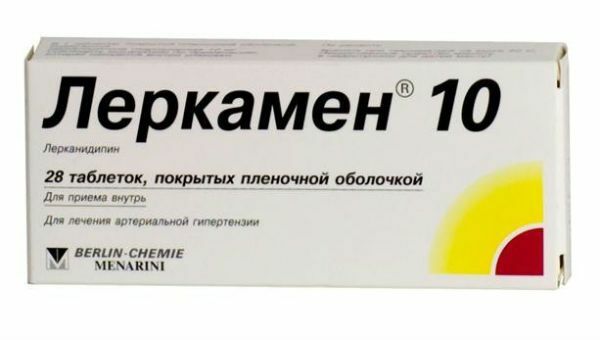
The active ingredient is lercanidipine. The form of release - tablets.
The drug is indicated for mild and moderate essential hypertension( I and II degrees).
Drink 10 milligrams 1 time per day. If necessary, after 14 days, you can increase the dose to 20 milligrams 1 time per day.
to contents ^Nicardipine( Barizin, Perdipin)
The active ingredient is nicardipine. The form of release - tablets, pills.
Has antihypertensive activity, it is used to prevent attacks of angina pectoris, with cerebrovascular disorders of the ischemic type.
Take 20 milligrams 3 times a day, the maximum daily dose is 120 milligrams. When the condition is stabilized, the dosage is halved.
to table of contents ^Nimodipine( Braleal, Nemotan, Nimotop, Nimopin)
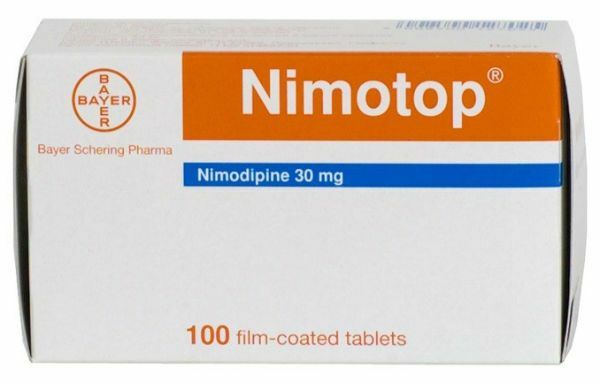
The active ingredient is nimodipine. The form of release - tablets.
The selective L-type calcium channel blocker acts primarily on the vessels of the brain, preventing and removing their spasms and improving blood flow.
Take 30 milligrams( 1 tablet) 3 times a day. In some cases, it is possible to increase the dose to 60 milligrams 6 times per day.
to table of contents ^Nifedipine( Cordaflex, Cordipine, Nifecard, Phenigidine)
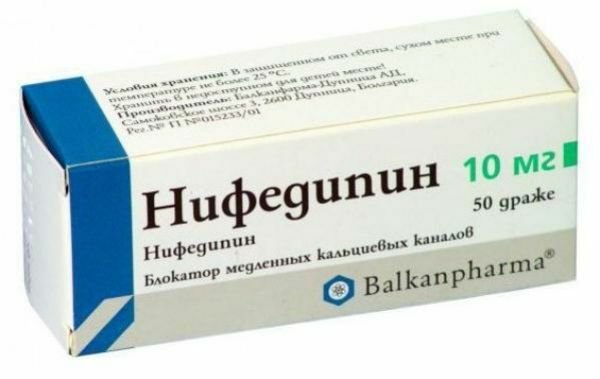
The active ingredient is nifedipine. Form release - a tablet of 10 milligrams, retard tablets( long-acting) of 20 milligrams, a solution for infusions( for intravenous and intracoronary administration).
Is an antianginal agent for coronary heart disease with angina attacks, reduces blood pressure in various types of hypertension, is used in the complex therapy of chronic heart failure.
Short-acting tablets taken internally 10-30 milligrams 3-4 times a day, but not more than 120 milligrams per day, the course of treatment is from 1 month. For relief of hypertensive crisis or withdrawal of an attack of angina pectoris - 10-20 milligrams sublingually( under the tongue).
Retard tablets are taken 20-40 milligrams twice a day or 40-80 milligrams once. Intravenously inject 5 milligrams for 4-8 hours, the maximum daily dose is 15-30 milligrams.
to table of contents ^Felodipine( Plendil, Felodip, Felotenz Retard)
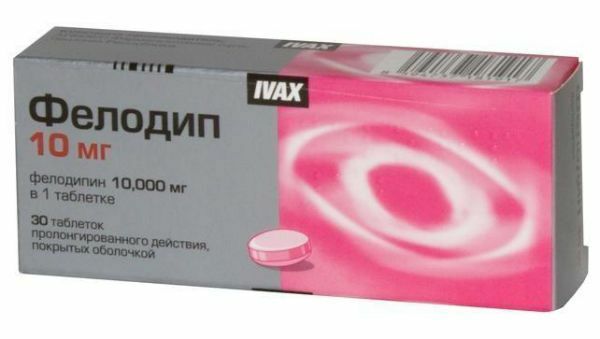
The active substance is felodipine. The form of release - tablets.
It is used for arterial hypertension, stable angina.
The dosage depends on the nature and severity of the disease and is 2.5-10 milligrams 1 time per day.
to contents ^Derivatives of phenylalkylamine
to contents ^Verapamil( Isoptin, Finoptin)
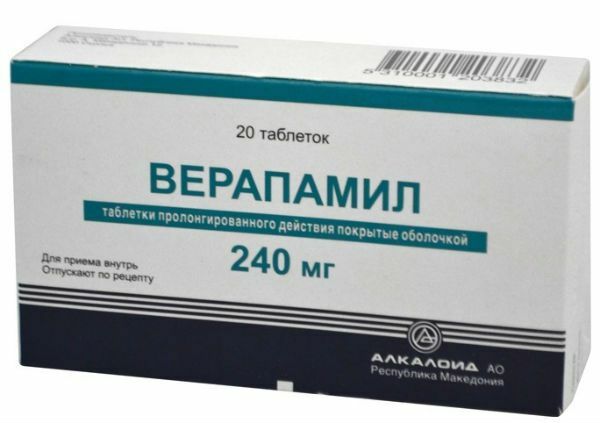
Active substance - verapamil. The form of release - tablets, a solution in ampoules for injections.
It is used for arterial hypertension, for the treatment and prevention of cardiac arrhythmias( paroxysmal supraventricular tachycardia, supraventricular extrasystole, flutter and atrial fibrillation), for all types of angina pectoris.
For tablets, the initial dose is 40-80 milligrams 3-4 times a day. If necessary, a single dose is increased to 120-160 milligrams, but not more than 480 milligrams per day.
Intravenous solution is administered for arresting attacks of heart rhythm disturbances - 5-10 milligrams with the possibility of recurrence after 30 minutes.
to contents ^Gallopamil( Procorum)
The active ingredient is gallopamil. The form of release - tablets.
Has antiarrhythmic, anti-ischemic and antihypertensive activity, reduces myocardial oxygen demand, causes coronary artery enlargement and increases coronary blood flow, lowers the tone of smooth muscle of peripheral arteries and general peripheral vascular resistance.
Take 50 milligrams 2-3 times a day at intervals of not less than 6 hours, the maximum daily dose is 200 milligrams.
to contents ^Benzothiazepine derivatives
to table of contents ^Diltiazem( Diacordin)
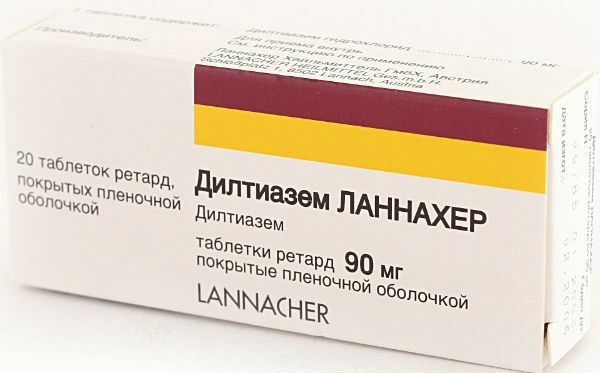
The active ingredient is diltiazem. Form release - tablets, tablets and capsules prolonged action, solution for intravenous administration.
It is prescribed after myocardial infarction, with arterial hypertension, angina pectoris, diabetic retinopathy, for the prevention of coronary spasm in surgical interventions.
Intravenously administered if necessary emergency therapy for tachycardia, atrial flutter, hypertension in the small circle of circulation, for arresting paroxysm of paroxysmal atrial fibrillation.
Tablets take 30 milligrams 3 times a day, increasing the dose every 2-3 days. Prolonged forms of the drug are taken at 60-120 milligrams 2 times a day with adjustment after 2 weeks, but not more than 480 milligrams per day.
to contents ^Derivatives of diphenyl piperazime
to contents ^Flunarizine( Sibelium)
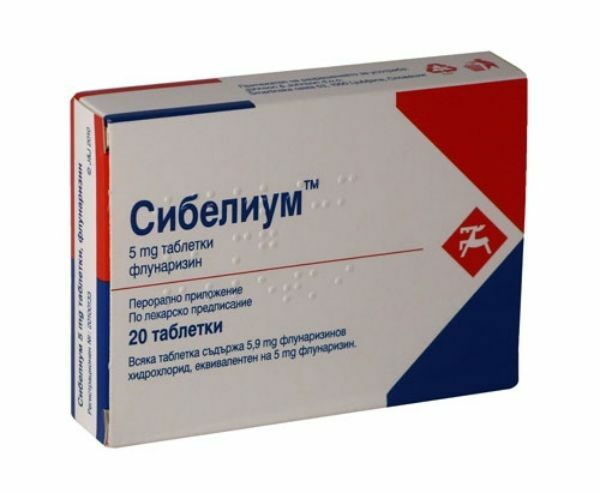
Active substance - flunarizine. The form of release - tablets, capsules.
The drug promotes relaxation of smooth muscles, improves cerebral circulation and oxygen supply to the brain, reduces vestibular disorders and frequency of seizures with epilepsy, and has antihistamine effect.
Take 10-20 milligrams 1 time per day before bedtime. Children with body weight less than 40 kilograms are prescribed half the dose for adults.
to contents ^Cinnarizine( Stugesin, Stugeron)

The active ingredient is cinnarizine. The form of release - tablets, capsules.
Effective in ischemic stroke and post-stroke conditions( including after hemorrhagic stroke), craniocerebral trauma, encephalopathy, vestibular disorders and kinetosis, migraines, dementia, peripheral circulation disorders.
Depending on the severity of the disease, drink 25-75 milligrams 3 times a day. The dose for children is half that of an adult. The course of treatment lasts from several weeks to several months.
